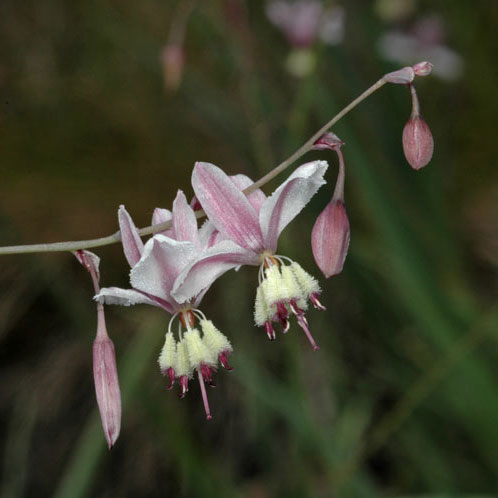Arthropodium milleflorum
 |
 |
Vanilla Lily
Arthropodium milleflorum (DC.) J.F.Macbr.
Arthropodium milleflorum is a tuberous perennial herb belonging to the Asparagaceae family. It is commonly known as the Vanilla Lily, due to the slight scent emitted from the flowers.
The species has a wide distribution along the east coast, from Queensland to South Australia and Tasmania. It is particularly prevalent on the Southern Tablelands (including the ACT) and in eastern New South Wales. It favours moist, grassy, sheltered slopes in open eucalypt forest, but can also be found in woodland, montane forest, and other grassland. It is listed as endangered in South Australia due to illegal collection for the horticulture trade, but is not considered at risk elsewhere.
The flowers appear between November and February on spreading or branching stems growing to 1 m. The flowers are hermaphroditic and consist of six white-lilac petals, purple anthers and distinctive white or cream hairy filaments. Fruits develop between December and March and are globular capsules to 5mm in diameter. At the base of the plant are dark green, strappy leaves, which grow to about 60 cm long.
The plant has traditionally been used as a food source by some Aboriginal groups. The tubers are eaten raw or roasted. The flowers are also edible. The presence of flowers may have signalled to hunters that game animals, such as bandicoots (which eat the tubers of this species), were nearby.
The plant has many features which make it ideal for the home garden or landscaping. It is low maintenance, frost tolerant and has relatively low water requirements. Some sources suggest it can go dormant in the drier months, which may make it more resilient to drought. A key feature of the plant is its flowers, which are pleasantly scented, insect attracting, and hang in dainty panicles along the arching stems. It is ideal planted en masse in a meadow, path border, rockery, or under trees, and can also grow in a pot.
In nature the plant is usually propagated by birds or small mammals eating the fruit and spreading the seed. It can self-seed to some extent, but does not become invasive. In cultivation, it is easiest to propagate by seed, which must be collected before they are shed from the fruit. Store seed in a cool, dry, place and sow into seed-raising trays in autumn or early spring. You may also be able to propagate by tuber division, dividing in winter and transplanting in spring.
Freya Clarke, Volunteer Botanical Training Program Participant 2017
Name meaning: Arthropodium milleflorumArthropodium - from the Greek arthron meaning joint and podion, a small foot, referring to the jointed pedicels milleflorum - from the Latin mille meaning one thousand and florum meaning flowers |
References:
Caton, J.M. & Hardwick, R.J. (2016) Field guide to useful plants of Temperate Australia. Harbour Publishing, Australia.
Cosgrove, M. (2014) Photographic guide to native plants of the ACT. Meadow Argus, Canberra.
Hunstone, J. (2017) Australian National Botanic Gardens horticulturalist, pers comm.
Mayfield, E. (ed.) (2006) Flora of the Otway Plain and Ranges, no. 1. Linton Press, Victoria.
Sharp, S., Rehwinkel, R., Mallinson, D. & Eddy, D. (2015) Woodland flora. A field guide for the Southern Tablelands (NSW & ACT). Friends of Grassland, Canberra.
Stewart, A. (2016) Arthropodium milleflorum – Pale Vanilla Lily. Available at http://www.gardeningwithangus.com.au/arthropodium-milleflorum-pale-vanilla-lily/ [Accessed 10 Feb 2017].
![An Australian Government Initiative [logo]](/images/austgovt_brown_90px.gif)


